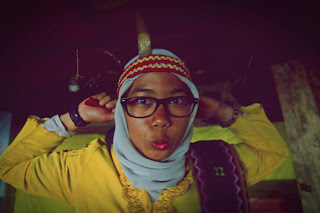You
can not say Melo like the way you say Mellow. A letter “e” in Melo is same as
“e” in “There”. Melo.
 |
|
A place where Melo Women weaving the Songket
|
Melo village is located in Desa
Liang Darat, kecamatan Sano Nggoang, Manggarai Barat, Flores, East Nusa
Tenggara. We can reach this village by motorbike or other transportation which
cost IDR 10.000 from Labuan Bajo. We reach this village at noon. That was so
quite, cloudy. Only a few people who walked away in this village. We didn’t see
others. When we sit in a big stone we feel the calm environment and we can see
the wide view of Flores from the top. It becomes misty while cloudy and fogged.
But it feels so different when we enter the wood house and meet the Melo
people. They have a sincere smile. We meet Yoseph Ugis, the elder of Melo
people. He said sorry for didnt give us a proper greet. Usually people call
Ugis first before come to Melo so that Ugis and the Melo can prepare the
Manggarai traditional dances such as Caci, the women weavering songket and Rea hat, traditional songs, and
some traditional games.
 |
| Melo children with their sweet smile |
 |
| The Original Manggarai Coffee. by Udin |
We
gathered in a warm house like a shelter called Sanggar Compang To’e. Mr.
Yoseph Ugis is the owner of Sanggar
Compang To’e. It built in 1993. Compang means raised
altar area in the center of village in Manggarai and To’e is
the name of indigenous Manggarai ethnic group. Compang To’e was established by Yoseph himself. He built it based of his love to his unique
tradition.
 |
| Inside Compang To'e. Children play the music by Udin |
While we talked about Compang To’e, Yoseph
showed some pieces of Songket weaved by the Melo women. He offered help our
host, Mad, to try the Songket. Mrs. Yoseph suddenly came to us and also gave a Songket for
woman. So, this is me wear a Songket with the Manggarai crown..
 |
| Hey..I wear the songket completely by Udin. Din..kenapa moto ginian pake wide sih, mukaku aneh.. tapi lucu :* |
 |
| Mr. Yoseph Help Mad to use it by Udin |
 |
| We love them!! by Udin |
It was an honor for me can use that traditional
Songket with Kebaya.
“Songket has some meaning,” said Yoseph. A pattern that has a vertical symbol in the edge
of Songket shows their believing to God. Second,
a pattern that form a line beside the flowers pattern is
a symbol of the unity of Manggarai in goodness and badness. Third, the flower
pattern reflects their life with the nature. Forth, the
black of Songket shows Manggarai people’s way of life as a farmer not as a
seller or others. The last, Songket is a religious symbol for Manggarai people. They use Songket in a special occasion
such as wedding ceremony, opening the new farm and sort of. The interesting one
is, when
someone use Songket and Rea hat, that man should talk with the indigenous
language.
 |
| The Rea with its symbol by Udin |
Mr. Yoseph Ugis almost use Rea hat every day. Rea hat is a cane work
like peci and the
pattern looks like a Songket. The different is, the
pattern of Rea only
focus in the shape of Mbaru Gendang, a traditional house of West Manggarai
which is reflecting the local’s social life. Songket and Rea are sold about IDR 5 up to 300 thousands. They hope people in the world know
about Songket and Rea and the government will help them to improve it.
Mr. Ugis has create a new song. He teaches Melo
children about the songs, the dances, the games and else. Fortunately, He asked
the children to sing the new song composed by him. We were hypnotized by the song. It’s a beautiful
song called Manik Lain which means The Beauty. In the last, one of them say
something about the song. What’s inside the song. She said about their unique
culture, the beauty of Manggarai, their believe in God. These were the
children said at the last of the song.
“Manik Lain song is telling us about the beauty. First, the
nature of West Manggarai Barat is so beautiful and unique. There are so many
pretty natural and unique destination, both in the sea and the land. Komodo is
more interesting. All of them are created by God. Second, the social culture of
Manggarai is precious and unique. There are beautiful and unique culture, those
are traditional musics and dances, especially The Caci traditional dance of
Manggarai. All of them are made by our ancestor. Let’s together keep and
continue the culture for our future.”
 |
| Bye Melo!! Hope we'll see you again. |
OMG.. u gonna post this @ international event :D
ReplyDeleteMehhh I am proud of you..! You are lucky girl ;) #hugs&kissees anywaaay.. I LOVE INDONESIA and MADLY PROUD TO BE INDONESIAN!
Thq mbak.. Iya ya, I should post this to the international event :D Thq idenya mbak..
DeleteLucky. I'm lucky and I'm blessed. Alhamdulillah